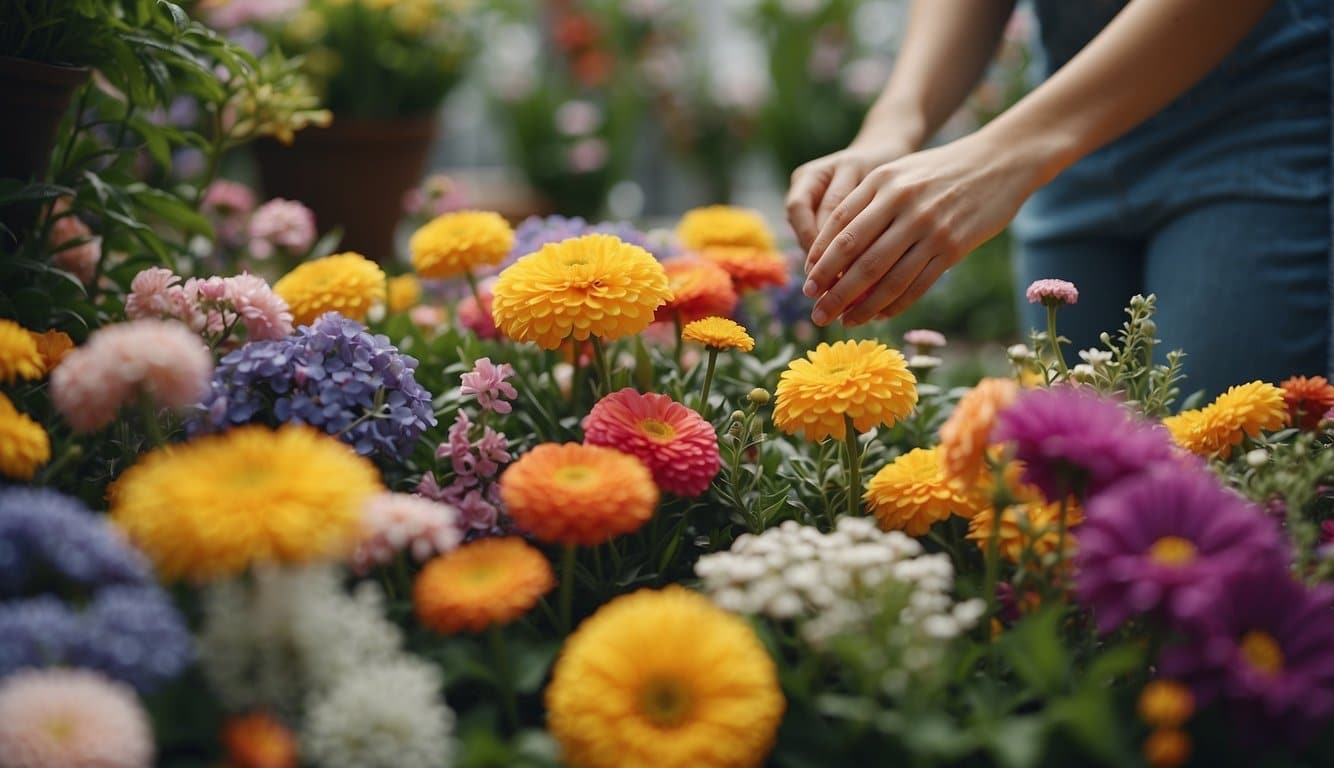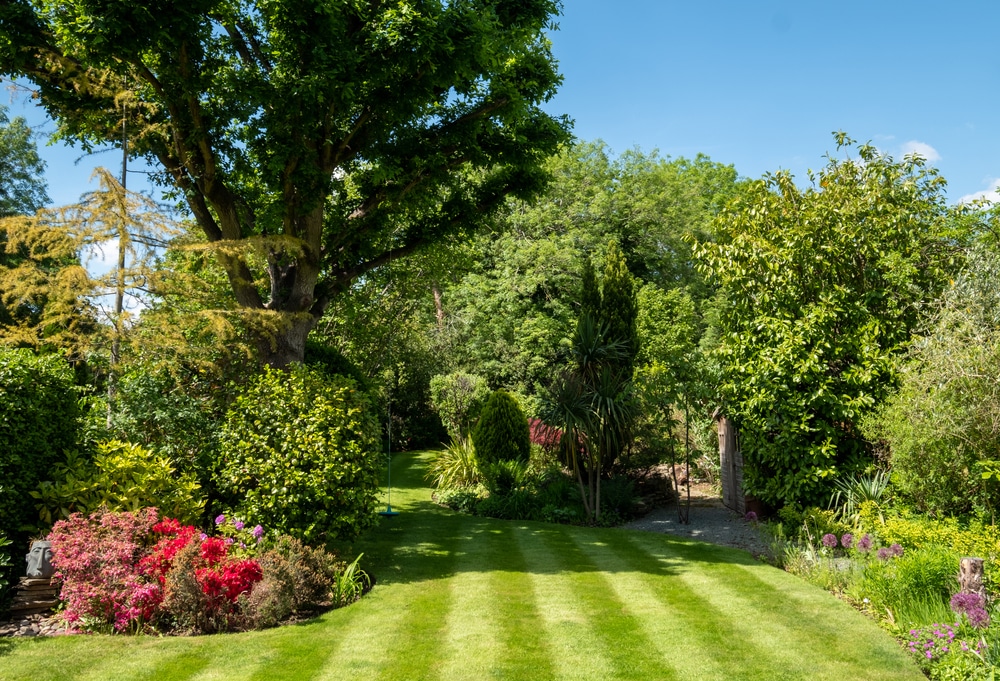The Color Wheel and Garden Design
In gardening, the color wheel is an essential tool for creating visually appealing landscapes.
It guides you in selecting plant combinations that harmonize well and evoke the desired mood in your garden.
Primary Colors in Nature
- Red
- Find it in foliage like Japanese maples or flowers such as roses.
- Yellow
- Brightens gardens with sunflowers or goldenrod.
- Blue
- Provides a calming effect with bluebells or delphiniums.
Color Harmonies for Garden Arrangement
Combining colors effectively creates a balanced and cohesive garden design.
Here are some harmonious arrangements:
- Complementary Colors: Colors opposite each other on the color wheel, like yellow and purple, can create a vibrant contrast.
- Analogous Colors: Colors next to each other on the wheel, such as green and blue, offer a more harmonious vibe.
The Psychological Effects of Colors
Colors in your garden can have a profound effect on emotions:
- Warm Colors: Red, orange, and yellow can energize a space.
- Cool Colors: Blue, green, and violet are soothing and create a serene atmosphere.
Selecting Flowers and Foliage for Your Palette
To craft a stunning spring garden, your selection of flowers and foliage is crucial.
Aim for a mix of seasonal blooms, varied plant types, and diverse foliage to create a visually appealing palette.
Considering Seasonal Blooms
- Research Early Spring Flowers: Look for tulips and daffodils that flourish in early spring, adding a burst of color after the winter months.
- Mid to Late Spring Options: Incorporate blooming perennials like irises and peonies which peak in beauty mid to late spring.
Balancing Perennials and Annuals
- Perennials for Longevity: Choose perennials such as daylilies and hostas for lasting structure in your garden.
- Annuals for Brightness: Utilize vibrant annuals like petunias and marigolds for eye-catching color that complements the perennials.
Incorporating Foliage Varieties
- Add Color with Foliage: Integrate plants with colorful leaves such as heucheras, which offer a spectrum of hues from silver to deep burgundy.
- Texture and Shape: Mix foliage shapes—ferns for soft, feathery textures, and broad-leafed hostas for contrast.
Designing the Layout of Your Spring Garden
Before you plant a single seed, a well-thought-out design, which incorporates both hardscaping elements and color-rich focal points, will pave the way for a breathtaking spring garden.
Structuring with Hardscaping Elements
- Pathways: Direct the flow of movement with a path made of stepping stones or gravel. This not only serves a practical purpose, but also adds texture and contrast within your garden.
- Borders and Edging: Define plant beds with brick or stone edging to create clean lines and prevent grass intrusion.
- Pergolas and Arbors: Install these to introduce vertical elements, around which you can arrange climbing plants and hanging baskets.
Creating Focal Points with Color
- Central Feature Planting:
- Choose a show-stopping tree or shrub with vibrant blooms as the centerpiece of your garden.
- Place this feature in a central location where it can be viewed from various angles.
- Color-Themed Beds:
- Organize your plants into color-themed beds for a harmonious appearance. For instance, pair pastel-toned flowers together to create a classic spring look.
- Use foliage in shades of silver or burgundy to provide a backdrop that makes the colors pop.
Planting and Maintenance Tips
Creating a vibrant spring garden requires attention to detail right from the soil preparation to the ongoing care of your plants.
Follow these specific tips to ensure your garden remains a colorful retreat.
Soil Preparation
- Test Your Soil: Checking your soil’s pH and nutrient levels is crucial before planting.
- Amend Accordingly: Tailoring your soil amendments based on the test results can lead to healthier plants and brighter blooms.
- Amend Accordingly: For most flowering plants, well-draining soil rich in organic matter is ideal.
- Amend Accordingly: Mix in compost or peat moss to improve soil structure and fertility.
Watering and Fertilization
- Water Wisely: Overwatering is as detrimental as underwatering. Aim for moderate, consistent soil moisture.
- Feed Your Flowers: Consider using a rain gauge to monitor natural rainfall and adjust your watering accordingly.
- Feed Your Flowers: Utilize a balanced, slow-release fertilizer to provide nutrients over time.
- Feed Your Flowers: Refer to guidelines for specific plant needs, as some may benefit from a bloom booster formula to encourage flowering.
Pruning and Deadheading
- Regular Pruning: Keep your plants healthy by removing damaged or diseased stems.
- Regular Pruning: This promotes better air circulation and reduces the chance of pest infestations.
- Deadheading: For many flowering plants, removing spent blooms encourages further blooming.
- Deadheading: Use sharp, clean shears and snip off the faded flowers just above the next bud or leaf.
Frequently Asked Questions
Creating a harmonious spring garden color palette requires thoughtfully combining flower color combinations and foliage, planning your color scheme, understanding which colors work well together, arranging colors for visual unity, and potentially using digital tools to assist you.
What are some effective flower color combinations for a spring garden?
- Pair the cool tones of blue and purple flowers with bright yellows for a vibrant contrast.
- Pink, lavender, and white blooms create a classic spring look that’s soft and inviting.
Which foliage can be added to a spring garden to complement floral hues?
- Incorporate silver or blue-toned foliage to complement pastel flowers.
- Bronze-green leaves transition to electric orange in cooler seasons, pairing beautifully with spring florals.
How do you plan a color scheme for a flower garden layout?
- Begin with the feeling you want your garden to evoke.
- Select a contrast level, choosing either a calming, low contrast palette or a bold, high contrast one.
What colors look good together when designing a spring flower garden?
- Use analogous colors, like reds, oranges, and yellows, for a warm, cohesive appearance.
- Contrast with complementary colors like purples with yellows for a dynamic display.
What are the best practices for arranging garden colors to create a cohesive palette?
- Repetition is key; repeat primary colors throughout the garden for continuity.
- Balance bright, dominant colors with neutral tones to prevent overwhelming the senses.
How can a flower color palette generator assist in selecting colors for a spring garden?
- A color palette generator can provide a visual representation of potential color combinations.
- It simplifies decision-making by allowing you to preview and adjust colors before planting.

